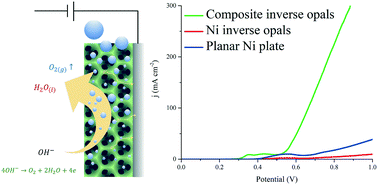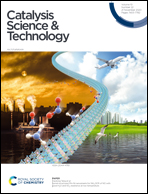Composite NiCoO2/NiCo2O4 inverse opals for the oxygen evolution reaction in an alkaline electrolyte
Abstract
Inverse opals are three-dimensional ordered macroporous materials whose pores are arranged in a hexagonal array with interconnected pore channels. These unique structural attributes provide an excessive surface area with facile mass transport. In this work, we fabricate a composite NiCoO2/NiCo2O4 thin layer encapsulating the skeletons of Ni inverse opals serving as the conductive substrate, and explore their electrocatalytic activities for the oxygen evolution reaction (OER) in an alkaline electrolyte. The NiCoO2/NiCo2O4 inverse opals are prepared by electroplating of NiCo alloy on Ni inverse opals followed by a mild oxidation treatment in air at 200 °C for 20 min. The X-ray diffraction patterns indicate mixed phases of crystalline NiCoO2, NiCo2O4, and NiCo, and images from scanning electron microscopy demonstrate the conformal formation of NiCoO2/NiCo2O4/NiCo on the Ni inverse opaline skeletons. Analysis from X-ray photoelectron spectroscopy determines the oxidation states for surface Co and Ni ions to be both +2 and +3. Electrochemical measurements including the active surface area and OER performance reveal a large surface area and strong OER activity with a relatively flat Tafel slope of 95 mV dec−1. In addition, from durability tests in both galvanostatic and potentiostatic modes, the sample shows impressive stability in both profiles while the inverse opaline structure is nicely maintained.



 Please wait while we load your content...
Please wait while we load your content...